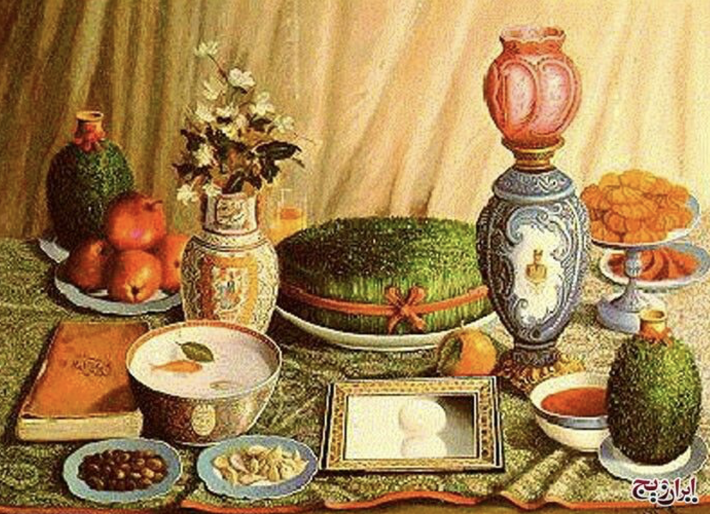Despite being born and raised in London, as an Iranian, I grew up celebrating Nowruz with my family every year. Nowruz (including alternative spellings such as Norouz, Navruz etc.) is a New Year’s celebration welcoming the Spring Equinox. Nowruz is celebrated by Iranians, Kurds, Azeris, Tajiks, Afghans and many other cultures around the world where Persian influences still thrive. The name Nowruz translates to ‘New’-‘Day’. The day and overall season is also commonly referred to as ‘Eid’ (pronounced by Iranians as ‘Eyd), similar to sacred festival days in Islam. In this context however, the term refers to a non-religious cultural celebration.
The turning of the year for 2024 falls on the 20th March at 3:06am in the UK. Iranians use the Solar Hijri calendar, which as I have learned, is not to be confused with the similar Islamic Hijri calendar, used widely across the Muslim world. The Hijri calendars are observation-based calendars, where the time of Nowruz is astronomically calculated each year at the vernal equinox; when the Sun crosses the celestial equator in a northerly direction. The Solar Hijri calendar is the most ancient and accurate calendar system known to us, with evidence of its existence found from the second millennium BC, possibly even predating the Iranian prophet Zoroaster. This introduces one major character to our Nowruz story.
Zoroaster is the prophet of the ancient, pre-Islamic religion of Persia – known as Zoroastrianism. This religion is pre-Abrahamic with communities still existing around the world. Many Zoroastrians, however were persecuted during the Islamic Conquest of Iran (then Persia), fleeing to moder-day regions such as India and Pakistan, where they are now known as ‘Parsis’. Freddie Mercury famously upset his Indian fans in a BBC interview, where the interviewer had identified him as Indian. Mercury corrected the interviewer by voicing his pride for his family’s indigenous practice of the Zoroastrian religion, saying “I’ll always walk around like a Persian popinjay, it’s a part of me and no one’s gonna stop me honey”. He later reassured fans that he embraces both his Indian upbringing and his Persian heritage.
Bringing us back to this millennium, my grandmother is very serious about her paper calendars. As well as her cleaning products, the burglar alarm and of course, the diligent preparation of homemade food. Two weeks before Nowruz, she would flatten Sabze seeds in a dish, and soak them with water, ready to sprout by Sizde Bedar. Sabze is a key addition to the Nowruz ‘spread’ known as Haft-sin, which translates to the “seven-Ss”, in Farsi. The number ‘7’ and the letter ‘S’ are related to the seven Amesha Sepantas (divine entities emanating from the Zoroastrian God, Ahura Mazda, revelated by the prophet Zoroaster) as mentioned in the religious scripture; Zend-Avesta. The Haft-sin spread therefore includes seven objects beginning with the letter ‘seen-ﺱ’. This typically includes the ‘Sabze’, ‘Samanu’ (sweet pudding made from wheat germ), ‘Senjed’ (Persian olive), ‘Serke’ (vinegar), ‘Sib’ (Apple), ‘Sir’ (Garlic) and ‘Sumac’ (Persian shrub spice). Two goldfish are also usually kept in a bowl at the Haft-sin to represent ‘sar’ and ‘sineh’ (head and heart). Eggs are also painted and put on the table to signify Spring, with similar evocations to Easter.
So, let us revisit my grandmother on the 13th day of New Year’s known as ‘Sizdah Bedar’, ringing her hands nervously at all of us. Pointing to the calendar she cries in the kitchen, ‘I never miss this day, I’ve mixed it up. Today is Sizde Bedar. I want everyone dressed and by the door by 11. We must go and throw the Sabze before noon.’ My grandparents’ house was by Kenwood Park, in the Heath. Every year, Iranians would pour into the forest, with picnics, music and football games to throw their sprouted Sabze (and sometimes goldfish) into the ponds for good luck.
I always thought my grandmother to be very superstitious. Her home always pristine, her days accounted for and all those anxious phone-calls to relatives in broken Azeri and Farsi. I grew up to discover that Iranians all around the world cling, just as hard to Nowruz traditions as she does. Some do so quietly in their homes and others proudly and courageously, jumping over the bonfires on Chaharshanbe Soori (translated as Fire Wednesday, on 12th March), but that story is for another day. For now, if you have made it this far, I am so joyous in having you on this journey, of the story of Nowruz. This year at University of Westminster, we are proud to announce our very own celebration taking place in March. We hope to see you there, with food, music, dancing and many more stories from Persia and our beloved global neighbours.
Anousheh Seddigh-Tonekaboni
